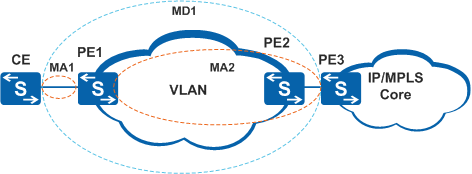Creating an MA
Context
CFM detects connectivity faults on a direct or end-to-end link. As shown in Figure 1, CFM is deployed between the CE and PE3 to detect connectivity of the link. PE3 is a Layer 2 device or a bridge between the Layer 2 device and Layer 3 device.
Before detecting faults, create an MD to determine the detection range, and create an MA and bind the MA to a service instance. You can configure multiple MAs in an MD. For example, MD1 is deployed on the network between the CE and PE3. You can create MA1, MA2, and MA3 in MD1 based on service types. An MA corresponds to and serves a service instance. Currently, the device supports only the VLAN service type.
The mappings between MAs and service instances are described as follows.
Networking |
Mapping |
|---|---|
Direct link |
When an MA such as MA1 is deployed on a direct link and both interfaces of the link are Layer 2 interfaces, the MA does not need to be bound to a service instance. |
End-to-end link |
When an MA such as MA2 is deployed on end-to-end networking, the MA needs to be bound to a service instance. Associations between MAs and service instances are different in different networking, as shown in Figure 1.
After an MA is associated with a service instance, packets from MPs in MAs carry the service instance tag. In addition, MPs in the MA can receive packets from other MPs in the same MA. Direct association between MAs and service instances is used as an example. See Creating a MEP for details of indirect association between MAs and service instances. |
Procedure
- Run system-view
The system view is displayed.
- Run cfm md md-name
The MD view is displayed.
- Run ma ma-name [ format { icc-based iccbased-ma-format-name | string ma-format-name } ]
ITU-T Y.1731 defines CCMs in ICC-based format. The ICC-based format is similar to the format of CCMs defined in IEEE802.1ag except for some fields. To be compatible with CCMs in ICC-based format, specify iccbased-ma-format-name.
ITU-T Y.1731 defines CCMs in ICC-based format. The ICC-based format is similar to the format of CCMs defined in IEEE802.1ag except for some fields. To be compatible with CCMs in ICC-based format, specify iccbased-ma-format-name.
- Perform the following configurations based on networking and service types.
Table 2 MA configurations in different networking Networking
Configuration Procedure
Detecting the directly connected link between Layer 2 interfaces on both devices
You do not need to associate MAs with service instances.
Detecting the end-to-end networking in a VLAN scenario
Create an MA on a Layer 2 device.
Run map vlan vlan-id
The MA is associated with a VLAN.
By default, an MA is not associated with any VLAN.
Create an MA on a device connecting the Layer 2 network to the Layer 3 network.
When creating a MEP on a device connecting the Layer 2 network to the Layer 3 network, specify a VLAN. The VLAN is automatically associated with the MA. For details, see Creating a MEP.
